| Back to Back Issues Page |
 |
|
The Goldfish Gazette, Issue #124 Care Comparison by Variety April 30, 2024 |
Goldfish Care TipsA Free Monthly Resource For Goldfish Enthusiasts In This Issue All Goldfish are not created equal, both in care requirements and competitive feeding abilities. Care Comparison By VarietyCare requirements vary significantly depending on the variety of goldfish you choose to keep. This is especially important to consider if you're planning on mixing goldfish varieties together in the same tank.Every day on social media there are posts showing aquariums with a mix of varieties that are totally unsuitable together, unless the owner has implemented a special feeding regime that ensures all inhabitants are receiving the same amount of food. Instead of listing over 100 Goldfish varieties and comparing the care requirements of each, I can broadly differentiate them by the 5 main physical characteristics that affect care requirements and feeding competitiveness, namely:
Under the broad categories I will give examples of varieties that fall into the category and those that need a special mention. I haven’t separated out dorsal-less varieties such as Ranchus and Lionheads because lacking a dorsal fin doesn’t seem to hinder their swimming ability much. I will specifically mention Celestials and Water Bubble Eyes as they are the two most developed varieties that require the most care. I have listed each variety mentioned under a grading, 1 being for the easiest variety to keep, 10 being the hardest. Single Tails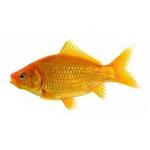
Care Level 1Common Goldfish A Common Goldfish is just a colored carp, with no changes to the physical appearance aside from color. It is genetically the strongest Goldfish variety, able to better withstand poor water quality, poor quality food, and a wide range of water temperatures.Care Level 2 Other varieties in this group are Comets, the most popular variety sold, and Shubunkins, both short and long finned.
Other varieties in this group are Comets, the most popular variety sold, and Shubunkins, both short and long finned.
I have graded these varieties a 2 only because of their longer fins, and Shubunkins have nacreous (calico) scales which genetically makes them slightly weaker than Common Goldfish. All these varieties can be kept together as the longer finnage doesn’t seem to hinder their speed around the aquarium. They are ideal varieties for beginners. Twin Tails With Normal Eyes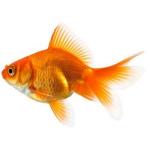
Care Level 3/4This group represents a large number of varieties such as Fantails, Ryukins, Orandas, Ranchu and Pom Pons.These varieties are not so tolerant of poor water conditions or food. They generally have deep bodies and are susceptible to buoyancy issues as they get older if not fed a diet with plenty of variety. Broadtail varieties of this group such as Orandas that have well developed flowing tail fins find moving through crowded aquariums difficult. Care Level 7/8
Varieties that develop wens such as Orandas, Ranchu and Lionheads can develop so much wen growth that the eyes are completely covered, effectively blinding the fish.
Telescopic Eyed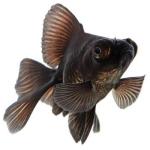
Care Level 5/6This group contains the most popular fancy variety sold, the Black Moor.Telescopic eyed varieties are at a severe disadvantage from normal eyed varieties because they have poor eyesight. They can see mid-distance but not close up or at a distance, so their ability to compete for food in a mixed aquarium is severely restricted. Broadtail Moors are further disadvantaged by their flowing fins. Moors should not be the smallest fish in a mixed aquarium as eyes often go "missing". The Celestial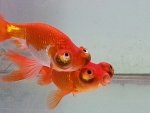
Care Level 9Celestials with their upward facing eyes have an even greater disadvantage than Moors. They cannot see sideways nor downwards.If their food isn’t floating on the surface, they have to find it by using smell. Celestials cannot be kept with other varieties. Water Bubble Eyes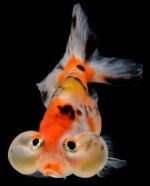
Care Level 10This variety is the most difficult to keep. The water bubbles beneath the eyes push them upwards so they have the same difficulty seeing food as do Celestials.The size of the water bubbles determines how mobile a fish is. Extremely large sacs restrict movement severely, so aquariums should not be cluttered with ornaments. Plants should be restricted to the sides and back of the aquarium. Water Bubble Eyes should not be kept with other varieties.
In conclusion, the level of care required for different goldfish varieties varies greatly. In an aquarium with 2 or 3 fish, varieties with wider care requirements, think Comet and Black Moor, can be kept together as long as the owner monitors food intake carefully, but even in this situation the owner will notice the Comet growing faster than the Moor. To learn more about Goldfish varieties and their care requirements click here... Comments? Ideas? Feedback? I'd love to hear from you. Just reply to this e-zine and tell me what you think, or what topics you want to be covered. Next Month's Topic Ornament dangerswww.facebook.com/aboutgoldfish |
| Back to Back Issues Page |